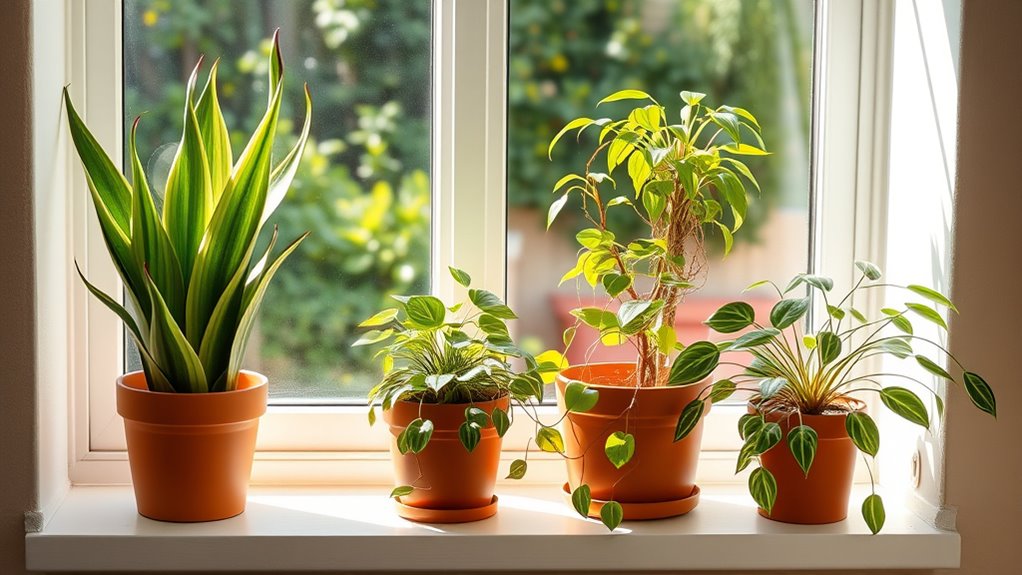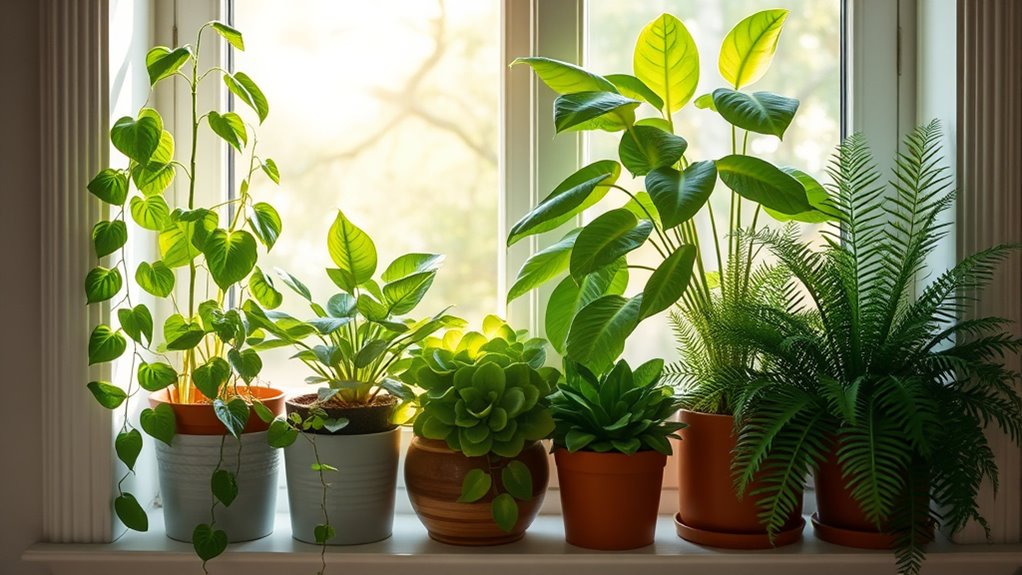If you’re new to indoor gardening, start with easy-care plants like pothos, peace lilies, or ZZ plants. These thrive in low to medium light, tolerate occasional neglect, and need only basic watering—check if the top inch of soil is dry before watering. Choosing resilient plants with high water content can boost your confidence. Keep an eye on signs of stress, and you’ll find maintaining healthy houseplants becomes simple. Continue exploring tips that will help your green space flourish.
Key Takeaways
- Choose low-maintenance plants like pothos, snake plants, and peace lilies that tolerate varying light and watering habits.
- Prioritize plants with high water content, such as succulents and cacti, for easier care and resilience.
- Assess your space’s natural light to select plants suited for low, medium, or bright direct sunlight.
- Avoid overwatering and ensure proper drainage to prevent root rot and keep plants healthy.
- Start with forgiving plants that tolerate occasional neglect, making indoor gardening accessible for beginners.

Starting your houseplant journey can be exciting, even if you have no prior experience. One of the most vital aspects of caring for your new plants is understanding their watering tips. Overwatering can drown roots and cause rot, while underwatering can leave your plants stressed and unhealthy. To get it right, check the top inch of soil before watering; if it feels dry, it’s time to give your plant a drink. Many beginner-friendly plants, like pothos or snake plants, prefer to dry out between waterings. Remember, consistency is key but avoid sticking to a strict schedule—let the plant’s needs guide you. Also, always make certain excess water drains freely from the pot to prevent soggy soil, which can lead to root rot.
Along with watering tips, understanding light requirements is essential for your indoor plants. Different plants thrive in different lighting conditions, so it’s helpful to assess your space before choosing what to bring home. Some plants, like pothos or ZZ plants, are adaptable and can handle low to medium light, making them perfect for shady corners or rooms with limited natural sunlight. Others, such as succulents or cacti, need bright, direct sunlight to flourish. To determine your plant’s light needs, observe the natural light patterns in your home. East-facing windows provide gentle morning light, while south-facing windows offer strong, consistent sunlight. If your space lacks sufficient light, consider supplementing with grow lights to give your plants a boost. Additionally, choosing plants with high water content can help ensure they are more resilient to occasional watering lapses, making them even more beginner-friendly.
When caring for houseplants as a beginner, it’s best to start with varieties that are forgiving and adaptable. These plants often tolerate occasional neglect and don’t demand perfect conditions. For example, pothos and peace lilies can survive in a range of lighting and watering habits, making them ideal starters. Keep in mind that consistent care practices, like watering appropriately and providing the right amount of light, will help your plants thrive. If you notice leaves yellowing or wilting, it’s a sign to adjust your watering or move the plant to a better-lit spot. As you gain confidence, you can experiment with different plants and refine your care routine.
Frequently Asked Questions
How Often Should I Water My Beginner Houseplants?
You’re wondering how often to water your beginner houseplants. A good watering schedule depends on the plant type, but generally, you should check the soil weekly and water when the top inch feels dry. This guarantees proper plant hydration without overwatering. Remember, consistent but moderate watering keeps your plants healthy. Adjust your schedule as needed based on the plant’s response, always aiming to maintain ideal moisture levels.
What Is the Best Lighting for New Indoor Plants?
Imagine walking into a cozy room where your new plants thrive. The best lighting for your indoor plants depends on lighting types like bright indirect, low, or direct sunlight. You should aim for about 12-16 hours of light daily, adjusting based on the plant’s needs. Consistent light duration helps your plants grow strong, healthy, and vibrant—just like that peaceful space you envisioned.
How Do I Prevent Pests on My Houseplants?
To prevent pests on your houseplants, follow pest prevention tips like inspecting plants regularly and avoiding overwatering. Keep your plants healthy, as strong plants resist pests better. Use natural pest control methods such as neem oil or insecticidal soap if you notice pests early. Quarantining new plants before adding them to your collection also helps prevent pest spread. Consistent care and observation are your best defenses against pests.
Can I Grow Houseplants in Low-Humidity Environments?
Did you know that around 50% of indoor plants can tolerate low humidity? You can grow houseplants in low-humidity environments by adjusting plant placement and choosing drought-tolerant varieties. Keep plants away from heaters and vents, and group them together to create a microenvironment with higher humidity. Using pebble trays or humidifiers also helps, making it easier to thrive despite low humidity levels.
What Are Common Signs My Plant Needs Repotting?
You’ll notice your plant needs repotting if you see rootbound symptoms, like roots circling the pot’s edges or emerging from drainage holes. Soil compaction also indicates it’s time to repot, as it prevents proper water absorption and nutrient uptake. When the plant looks crowded or stops growing, it’s a clear sign you should choose a larger pot and refresh the soil to promote healthy growth.
Conclusion
Now that you know these easy indoor plants, your home can transform into a lush oasis. Think of each plant as a tiny, green friend waiting to thrive under your care. With patience and a little love, you’ll watch your space come alive, creating a sanctuary that’s both beautiful and calming. So, why not start today? After all, even the smallest plant can grow into something extraordinary with your nurturing touch.








